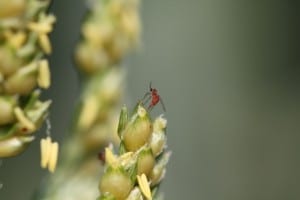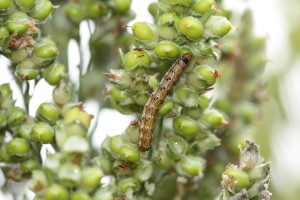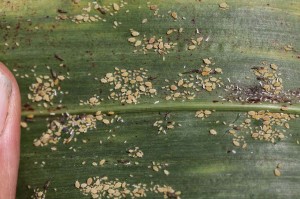There are several things to be scouting for in grain sorghum. Below are some suggestions and management considerations. Typically, later maturing fields will be at higher risk to head feeding caterpillars and sorghum midge, so be especially mindful if your fields are just now or not yet heading.
-

Sorghum Midge Sorghum Midge – This small fly is rarely a problem in early planted sorghum. The worst infestations usually occur in later maturing fields, especially if earlier maturing fields are nearby. However, if fields have a lot of uneven head emergence, populations can build up and attack the later maturing heads. Johnsongrass is an alternate host, so fields with a lot of Johnsongrass are at higher risk. I don’t see many fields infested with soghum midge, but they can do an impressive amount of damage in rare cases. The fly causes no damage but lays eggs during flowering. The larvae feed inside the grain, so you can only control the adults. The treatment threshold is one adult midge per head during bloom. Sampling can be done by visual inspection or by placing a thin, clear plastic bag over a head and looking for the small orange flies that land on the bag when the head is gently shaken. Sorghum midge is easy to control with pyrethroid insecticides, but multiple applications are occasionally justified during bloom.
-

Corn Earworm Headworms – This includes corn earworm, fall armyworm, and sorghum webworm. Corn earworm in particular is a common pests, and again, very common in later maturing fields. If your fields are just now or not yet headed, then you should expect to spray for headworms. The treatment threshold for corn earworm and fall armyworm is one larvae per head. For webworms, treat when three or more larvae are present per head. Recent experience suggests that the pyrethroid insecticides will not provide great or extended control of either corn earworm or fall armyworm in sorghum. There are better, albeit more expensive options, such as Lannate (24 oz/a), Belt (2-3 oz/a), Besiege (7 oz) and Prevathon (14 oz/acre). I think these are worth the money if facing high pressure. Some premixes should also provide better control than the pyrethroid insecticides alone (e.g., Stallion, Cobalt Advanced).
-

Photo courtesy of David Kerns (LSU AgCenter) White Sugarcane Aphid – I’ve touched on this before (link to article), but I need some eyes looking for this new threat. It is unclear whether white sugarcane aphids will make it to Tennessee, but it is knocking on the door. It has been found as far north as Crittenden County, Arkansas, so it is across the river from Shelby and Tipton Counties. This pest can go from 0 to 60 in a hurry and has become a serious problem to our south. Insecticide options are very limited. Indeed, I’m looking for some early warning so that I can apply for a Section 18 request that would allow the use of Transform if necessary.


We’ll be on the lookout in Tipton! Thanks for the timely info as always!